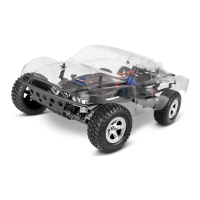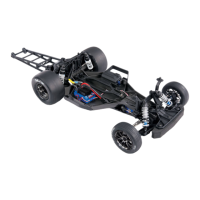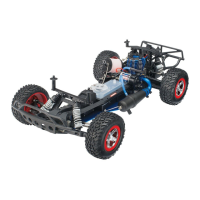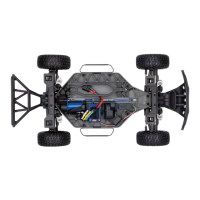Do you have a question about the Traxxas Slash 58034-1 and is the answer not in the manual?
Traxxas support is available for your model via phone and online resources.
Overview of procedures to get your model up and running quickly.
Icons indicating warnings, helpful hints, and cross-references within the manual.
Contact Traxxas for questions about your model or operation.
Register your product online within 10 days of purchase for better service.
Key operational safety reminders for model use, including traffic and crowds.
Precautions for the XL-5 ESC to prevent damage or malfunction.
Proper recycling of Traxxas Power Cell NiMH batteries.
Critical warnings and hazards associated with LiPo battery use.
Precautions for charging and handling all types of batteries.
Safe practices for charging batteries, including location and materials.
General safe handling practices for batteries and chargers.
List of tools and equipment supplied with the model.
List of equipment required for operating the model.
Optional but recommended tools for R/C toolbox.
Diagram identifying the major components of the Traxxas Slash model.
Understand safety precautions for personal injury avoidance.
Fully charge the included battery pack before setup.
Properly install the receiver antenna and antenna tube.
Install 4 AA batteries into the transmitter.
Install the fully charged battery pack into the model.
Turn the transmitter on first, then the model.
Verify that the steering servo is functioning correctly.
Test the radio system for proper operation at a distance.
Apply other decals if desired for personalization.
Learn driving tips and adjustments for your model.
Follow steps to maintain performance and running condition.
Instructions on how to lift and apply decals to the model.
Overview of the TQ 2.4GHz radio system and its features.
Familiarize yourself with radio and power system terms used in the manual.
Explanation of the ESC's thermal shutdown feature.
Description of the TQ 2.4GHz system's two channels.
Details on the 2.4GHz technology for improved radio performance.
Explanation of voltage in relation to the model's power system.
Reference numbers for motor sizes.
Key precautions for maintaining radio range and preventing signal loss.
Diagram showing the wiring connections for the XL-5 ESC and receiver.
Identification of controls and components on the transmitter and receiver.
Diagram of the XL-5 ESC and its connections.
Instructions for installing 4 AA batteries in the transmitter.
Instructions for charging the Traxxas NiMH battery pack.
Explanation of the charger's LED indicators and their meanings.
Guidance on selecting and using appropriate batteries for the transmitter.
Explanation of Traxxas Battery iD for automatic charger recognition.
Step-by-step guide to installing the battery pack in the model.
Information on fitting different battery pack sizes and types.
Description of the Traxxas High-Current Connector for optimal power.
Essential rules for operating the radio system safely and effectively.
Identification of the transmitter's controls like steering wheel and trim.
Adjusting steering trim for proper alignment.
Instructions for reversing steering and throttle channels if needed.
Step-by-step guide to reverse the steering channel.
Step-by-step guide to reverse the throttle channel.
How to use the throttle trigger for braking and reverse.
Checking and adjusting the radio system for correct operation.
Procedure for testing the radio system's range before each use.
Tips for maintaining control at higher speeds and longer distances.
Table of transmitter LED patterns and their meanings.
Table of receiver LED patterns and their meanings.
Steps to electronically bind the transmitter and receiver.
Instructions for properly installing the antenna and tube.
Explanation of the built-in fail-safe function.
Technical specifications for the XL-5 electronic speed control.
Procedure to check if Low-Voltage Detection is disabled.
Steps to activate Low-Voltage Detection for LiPo batteries.
Steps to disable Low-Voltage Detection for NiMH batteries.
Guide to calibrating the ESC with the transmitter.
How to operate the speed control and test programming.
Guide to selecting different operating profiles for the speed control.
Instructions for selecting Sport Mode.
Instructions for selecting Race Mode.
Instructions for selecting Training Mode.
Explanation of LED indicators and protection modes.
Details on the benefits of Training Mode for new drivers.
Quick tips for changing between speed control profiles.
Procedure to recalibrate the speed control if neutral position changes.
Key safety and operational precautions to keep in mind before driving.
Factors affecting run time and how to estimate it.
Methods to extend the run time of your model.
How battery capacity affects performance.
Information on driving the model in wet conditions and its precautions.
Specific precautions for running in wet conditions.
Steps to take before operating the model in wet conditions.
How to prepare tires for wet running by cutting holes.
Ensuring the watertight seal of the receiver box.
Steps for removing and installing the receiver and related components.
Detailed steps to remove the receiver from its box.
Detailed steps for installing the receiver back into its box.
How to adjust the slipper clutch for optimal tire spin regulation.
Information on stock and modified motors and gear ratios.
Chart showing compatible gear combinations and their effects.
Procedure for setting the gear mesh to prevent stripped gears.
How to set toe-in for proper steering and stability.
How to adjust camber angle for optimal wheel alignment.
Adjusting shock oil and springs for different driving conditions.
Guide to selecting shock mounting positions for performance.
Procedure for re-centering the steering servo.
Check for cracked parts, binding, wiring issues, and loose components.
Regular maintenance tasks for the slipper clutch, motor, shocks, and suspension.
Inspection and replacement of slipper clutch friction material.
Keeping the chassis clean and inspecting for damage.
Identifying and replacing worn steering components.
Proper procedures for storing the model and transmitter.
| Brand | Traxxas |
|---|---|
| Model | Slash 58034-1 |
| Category | Motorized Toy Car |
| Language | English |











